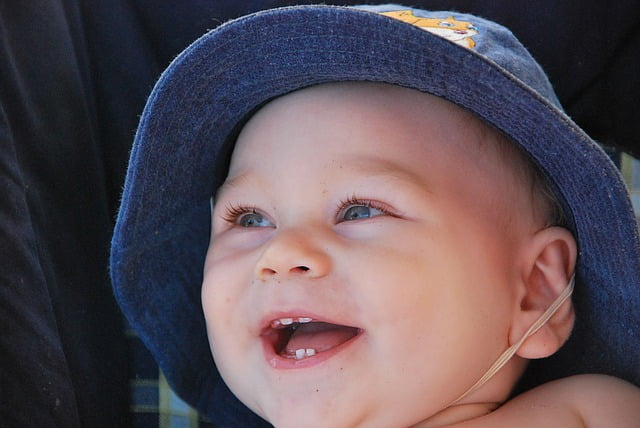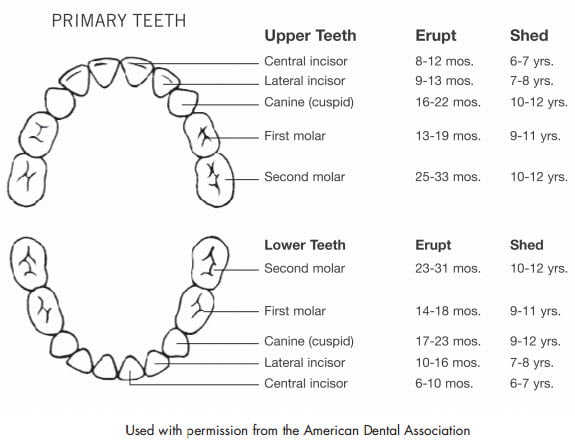
What Is Teething?
Teething is medically referred to as odontiasis. It is the period of time when your baby’s teeth start to come through their gum line.
When Do Babies Start Teething?
You probably picture your baby’s first year – smiles, cuddles, milestones, and other fun things. Then comes the teething phase. Your child can become a cranky, unhappy baby quickly when they start to teeth. This is because that tiny white tooth is trying to get through their sensitive gums.
Babies will usually get their first tooth at 6 months old, although there is no specific age. Some babies feel the discomfort and pain of teething as soon as they are 3 months old. Some babies may wait until their first birthday to get their first teeth.
All babies have different needs when it comes to their teething phase. However, most babies are likely to get their first tooth in their first year.
Learn how to tell if your baby is starting to teeth and which order they are most likely to be appearing in.
Early Signs and Symptoms of Baby Teething
Every child’s response to teething is unique. There are some signs that your baby might be teething.
Crying and Irritability
A noticeable shift in a baby’s mood is one of the signs that they are teething. Sometimes even the most happy baby can suddenly get irritable. You may notice your baby crying more often or becoming more agitated. This mood change will usually be greater in the first few weeks of the child’s first tooth, but it gradually gets increased with other subsequent teeth. They may become more irritable after their second year when their molars start to show.
Excessive Drooling
Excessive drooling is another sign that your baby may be experiencing teething. This can begin as young as 10 weeks old in some infants and last throughout their teething journey. It’s not uncommon for a baby to soak their shirt or their parent’s shirt within minutes of drooling from teething. Parents and babies should not endure wearing damp clothes. A rash can develop around the neck, chin, and mouth if there is too much drooling. So parents should have bibs that keep their baby’s clothing from getting wet.
Biting and Gnawing
A growing interest in biting can be a sign of teething. Counterpressure can help relieve the pressure caused by a soon-to-erupt tooth. Teething babies instinctively look for something to chew on in order to relieve the pressure and counter their pain. Your little one may try to chew or bite everything they find. This can cause pain for older babies with a few teeth.
Disruption in Eating and Sleeping Habits
Teething can be a 24-hour endeavor, so it has a major impact on every aspect of a child’s daily life. Teething may make it difficult for a child to drink or nurse from a bottle. Tooth-sensitive gums may also be affected by sucking. They may also refuse to eat solid food they loved days ago if they are older. Teething pain can also disrupt their sleeping pattern. A baby who used to sleep through the night before teething might wake up more often at night.
Ear Pulling and Cheek Rubbing
During the process of teething, a baby might pull at their ears or rub their face. All three of the nerve pathways that run through our ears, cheeks, and gums are identical. This means that pain from teething can be felt also in the ears and cheeks. This is especially true for babies who have just started to cut their molars. This symptom can also be caused by an ear infection that is usually accompanied by other cold or flu-like symptoms like fever and congestion. So it’s worth talking to your pediatrician if the symptoms persist for longer than seven days.
Other Symptoms of Baby Teething
Sometimes baby teeth can emerge without any pain or discomfort.
Therefore you might also notice the following that your baby’s:
- gums are red and sore where the root is going through
- has an average temperature of 38℃
- has one flushed cheek
- has a rash across his or her face
Baby Teething Timeline
While your child’s teeth develop while still in utero and continue to grow until your baby reaches the end of his or her first year, your baby’s teeth will not be able to cut through the gum line until a few months later. While the teething age of a baby varies, it is generally expected that teething will occur in the following order:
3 to 6 Months: Signs of Teething Starting to Happen
Parents often notice their baby drooling and feeling uncomfortable as soon as they are born. However, this doesn’t necessarily mean that a new tooth will soon appear. Some babies may show signs of gum sensitivity and early tooth development for up to six months. While you wait for your baby’s tooth to emerge, it’s crucial to manage his or her discomfort and pain.
6 to 12 months for the First Tooth
A child’s average age for their first tooth is 6 months. However, it’s important that you remember this number is only an average. Some children are born with their first teeth earlier than others, while some children have them much later. No matter what age they are when their first tooth comes in, the front tooth will always be the one that appears. After your baby cuts their bottom incisors the first four teeth that will appear are their top teeth.
12 Months: The Molars Appear
You’ll notice signs of molars in your baby’s gums around their first birthday. Molars are also very painful and parents might notice that their baby is reverting to their previous teething signs – excessive drooling or irritability. The canines, which are the pointed teeth between the incisors or molars, will also appear at this point.
12 to 24 Months: The End of the Teething Process
The first year of your baby’s life, the primary teething stage starts where molars start to appear. The first set of molars appears at age 1. As your baby approaches age 2, the second set will appear. Because of their broad, flat surfaces that break through the gums, molars can be very painful. Like with the earlier teeth, it is important to manage your baby’s discomfort and get your child through this difficult time.
How to Soothe Your Teething Baby
Some babies find it difficult to endure teething, however there are many ways that you can make the process easier for them.
It is not fun to watch your baby suffer through the pain of teething. Each baby is unique, so you might have to experiment with different methods until you discover the right one for your baby.
Teething Rings and Toys
Your baby will be able to safely chew on the teething rings. It can help to ease discomfort or distract from pain.
You can also cool some teething rings in the refrigerator first, to help soothe your baby’s gums.
Instructions included with your teething ring will tell you how long it should be kept chilled.
Avoid putting a teething band in the freezer. It could cause damage to your baby’s gums or developing teeth.
You should also avoid tying a teething ring around the neck of your baby, as this could pose a danger of choking.
When Your Baby Starts Chewing
If your baby starts to bite or chew on toys, their fingers or any other object they hold onto, it is a sign that they are starting to have teeth.
You can offer your baby healthy foods to chew, as long as they are 6 months old or older. Ideal food to give are pieces of carrot or apple. You can also give your baby a slice of bread or breadsticks.
Keep your baby close to you when they eat as they can easily choke. It is very important to learn what you can do for your baby if he or she starts to choke
Avoid giving your baby biscuits, as almost all brands have some sugar. Sugary foods should be avoided, since they can lead to tooth decay in children with only a few teeth.
Teething gels
It is very important to know that the effectiveness of teething gels is not proven. Parents should first consider non-medical alternatives for their child’s teeth, like teething rings.
Use a gel if you decide to do so but with the prescription of a pediatric dentist or pediatrician. Children should not use general pain relief gels for their oral health.
The best place to get teething gels is the pharmacy as they contain mild local anesthetics. For further information, consult your baby’s pediatrician.
Homeopathic teething gels have not been proven to be effective as well. You should ensure that the homeopathic gel you are using is licensed to be used in the United States. Be very careful of choosing teething gels as there have been serious side effects linked to some unlicensed homeopathic products advertised online. A list of homeopathy teething gels licensed by the Food and Drug Administration is available online.
Make Sure your Baby’s Mouth and Face Are Always Dry
Your baby’s drool must be dried off their clothes and cheek at all times. There’s a high chance that your baby will get skin irritation if you don’t dry it off their cute clothes and chubby cheeks. Teething bibs are a great option if you do not want your baby to have to change his or her clothes as often. They can capture saliva and other liquids, and they are simple to take off and put back on throughout the day. To prevent skin irritation, you can use Aquaphor and Vaseline on your child’s skin.
Paracetamol or Ibuprofen for Teething Babies
You may give your child a painkiller that is sugar-free if they are in severe pain.
For babies, young children and toddlers (3 months or older), paracetamol and ibuprofen may be used to alleviate teething pain.
Aspirin should be avoided in children under 16 years of age.
Follow the directions that came with the medicine.
Talk to your pediatrician and pharmacist if you’re not sure.
Comforting and Playing with Your Baby
Playing with or comforting your baby may help to distract them from the pain of teething.
It may be helpful to gently rub their gums using a clean, dry finger.
Talk to a Pediatrician
The pediatrician of your child can help you soothe your baby’s teething pains. You can get advice from them on how to best use non-medicated products for pain relief and discomfort, such as acetaminophen.
Trust Brightest Smiles Dentist Finder to Find the Best Pediatric Dental Care Near Your Area
The American Dental Association suggests that children have their first checkup six months after the eruption of their first tooth or when they turn 1 year old. A regular dental exam can ensure that your child’s teeth are developing properly and help prevent future problems. Brightest Smiles Dentist Finder will assist you in finding a group of dental specialists who are committed to caring for your child’s gums and teeth every step of their journey.
To schedule the first appointment for your child’s pediatric dentist, call us today.
Show references
- American Dental Association/Mouth Healthy: “Teething”
- Food and Drug Administration: “FDA Drug Safety Communication: Reports of a rare, but serious and potentially fatal adverse effect with the use of OTC benzocaine gels and liquids applied to the gums or mouth.”
- American Academy of Pediatric Dentistry: “Frequently Asked Questions”
- Children’s oral health. Centers for Disease Control and Prevention: https://www.cdc.gov/oralhealth/basics/childrens-oral-health/index.html
- American Academy of Pediatrics: “Teething: 4 to 7 Months,” “Teething Pain,” “Children’s Oral Health,” “Amber Teething Necklaces: A Caution for Parents”






